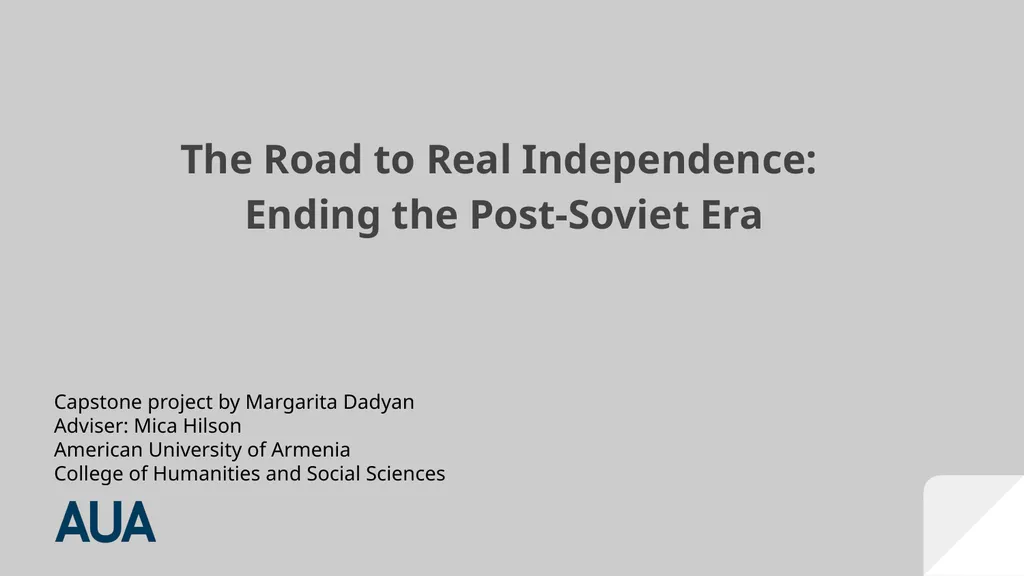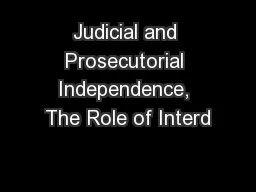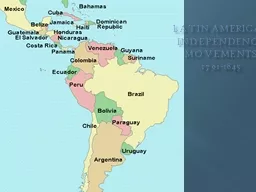The Road to Real Independence: Ending the
Author : aaron | Published Date : 2025-07-16
Description: The Road to Real Independence Ending the PostSoviet Era Capstone project by Margarita Dadyan Adviser Mica Hilson American University of Armenia College of Humanities and Social Sciences Introduction The 20th century ended by the fall of
Presentation Embed Code
Download Presentation
Download
Presentation The PPT/PDF document
"The Road to Real Independence: Ending the" is the property of its rightful owner.
Permission is granted to download and print the materials on this website for personal, non-commercial use only,
and to display it on your personal computer provided you do not modify the materials and that you retain all
copyright notices contained in the materials. By downloading content from our website, you accept the terms of
this agreement.
Transcript:The Road to Real Independence: Ending the:
The Road to Real Independence: Ending the Post-Soviet Era Capstone project by Margarita Dadyan Adviser: Mica Hilson American University of Armenia College of Humanities and Social Sciences Introduction The 20th century ended by the fall of the Soviet Union and the beginning of the democratization process of the newly independent countries. By the beginning of the 21st century the traces of the failure of the democratization process in most of these countries could have already been noticed. These countries became democracies on official documents and speeches of their leaders but stayed hybrid regimes in reality that were strongly tied to Moscow. This was a natural and unavoidable process because thought physically the Union dissolved the mentality and most importantly the inertia remained. Main thesis Even after the fall of the Soviet Union Moscow stayed and continues to stay the decision-making center for the post-Soviet territory. Revolutions to establish real democracy and gain sovereignty were done in some of the post-Soviet states including Ukraine, Georgia and Armenia. Reasons for this outcome are multiple but the following paper will examine these revolutions, concentrating mainly on the case of Armenia, to understand their reasons and political implications. Union dissolved but not the Ideology The collapse of the Soviet Union also meant losing the war on ideology (capitalism of the West versus socialism of the Soviet Union). Turned out that Western-model capitalistic states with free market economy and democratic institutions are more successful. Therefore, it is of no surprise that all the post-Soviet newly independent states declared to be democracies following the Western model with an undeclared aim to get rid of failed institutions of Soviet era. Alongside with these processes Russia was forming its way of moving forward and later imposing that on post-Soviet states that it perceived and continues to perceive as its zone of influence. The aim of the revolutions in Georgia, Armenia and Ukraine was about turning a post-Soviet state into a successful democracy. Armenia 2018 Velvet Revolution Leader: Nikol Pashinyan Agenda: Declared to be only internal 2004 Orange Revolution Leader: None Agenda: internal (to stop electoral fraud) 2014 Ukrainian Revolution (knows as Euromaidan) Leader: none Agenda: external (demands to join EU instead of EAEU) Georgia Ukraine 2003 Rose Revolution Leader: Mikheil Saakashvili Agenda: Internal and external Revolutions Goal of the Revolutions The goal for all of the three revolutions was to end corruption, boost the economy, increase the life














